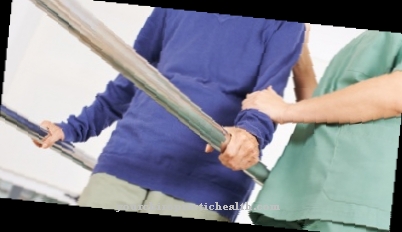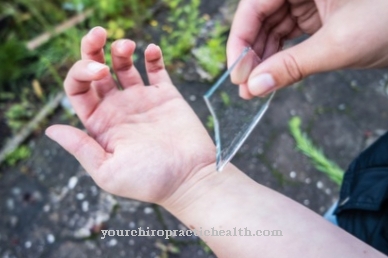Wound pain are important warning signals to draw attention to disorders and diseases that can be dangerous for the body. Therefore, injuries, whether from surgery or accidents, are always associated with pain. They can even persist beyond healing.
What is wound pain?

Designate as a generic term Wound pain any pain associated with wounds. In addition to the pain caused by the injury itself, this also includes the pain caused by the healing process.
Added to this are the pains that arise as a result of the healing process, e.g. through proliferating scar tissue. If a wound also radiates pain over the damaged area, this also counts as wound pain.
Their character is usually sharp and burning, which is felt to be very painful. In principle, it is also true that smaller injuries are associated with less wound pain than large ones.
causes
Reasons for Wound pain are always tissue injuries that set a complex biochemical process in motion. Depending on the severity of the injury, the bleeding will vary in intensity. At the same time, the body produces pain-releasing substances in the affected areas.
They activate the nerve cells located in the injured tissue, which in turn conduct impulses via nerve pathways to the brain, where the pain is processed. The triggers for wound pain are diverse. These include, in particular, injuries from cuts, bruises, stitches, stakes, bites and bullets.
Extreme cold (frostbite) or heat (burns, scalds) also lead to painful injuries. Wound pain is also caused by pressure and friction with prostheses.
Phantom pain is also considered a special form of pain or wound pain. They occur after limbs have been amputated, although the part of the body that was perceived as painful is no longer there.
Diseases with this symptom
- Bruises
- Phantom pain
- Cut
- Hypothermia
- Burn wound
- combustion
Diagnosis & course
If an injury has occurred, the severity is determined first. Before each treatment, it must be clarified whether the skin abrasions are superficial with rather minor ones Wound pain acts or deeper wounds.
This includes severing the skin, damaging other layers of tissue in the body or even the most severe injuries in body cavities such as the skull, chest and abdomen. However, it should be noted here that the severity of the injury does not automatically correlate with the intensity of the wound pain.
Since the perception of pain depends on a large number of factors, there are great individual differences in the way patients process pain. After accidents and operations, they sometimes experience the pain they want to be more intense than it actually is, as studies have shown.
Complications
Wound pain does not always have to be treated. If they appear after a minor accident or after a bruise, they usually heal relatively quickly and leave no scars. In this case they do not have to be treated and do not lead to further complications. However, if the wound pain occurs after a major accident and the wound bleeds, a doctor must be consulted.
It is advisable to cover the wound with a bandage so that dirt does not become infected. To avoid wound pain, the wound should be covered with a pressure bandage or plaster as soon as it occurs. Treatment by the doctor must take place if the wound is extremely painful and thus restricts everyday life.
It usually takes the form of surgery or medication. Pain relievers can be used to relieve the pain. However, long-term use should be avoided as the pain relievers attack the stomach. Complications only occur in rare cases. In most cases, the wound pain will go away in a short time and will not require treatment by a doctor.
When should you go to the doctor?
Wound pain doesn't always need medical treatment. Pain that occurs after minor bruises or accidents usually disappears after a few days and does not require any further clarification. However, if the symptoms persist longer than usual, a doctor must be consulted. This is especially true if the pain is associated with an infection of the wound or an impaired healing process.
Wound pain after a serious injury must always be treated by a doctor. The same applies to pain that occurs after an operation and appears unusually severe. The attending physician must then ensure that the wound heals without any further complications and that no inflammation or scars occur, for example.
In addition, wound pain should be clarified if it is particularly intense or restricts everyday life. Infants and young children who complain of pain after an operation or a fall must be taken to the pediatrician or hospital. If the problem is nerve pain, a neurologist should be consulted in consultation with the family doctor.
Doctors & therapists in your area
Treatment & Therapy
The primary goal in treating wounds is to avoid infection. They not only endanger the healing process, but can also Wound pain sustainably increase. It is therefore necessary to prevent bacteria, viruses or other substances from getting into the wound. Therefore, wound care is of fundamental importance for the entire healing process.
It should also be noted that injuries heal differently depending on the severity. Cut wounds usually show little damaged tissue with smooth edges. These are good prerequisites for bringing the wound edges back together. This is done by sewing or a plaster bandage. Cut wounds usually close within 6 to 8 days after a superficial scab has formed.
In the event of bruises, all destroyed tissue must be removed as quickly as possible. The aim is to create smooth and above all well perfused wound edges everywhere. They too will be brought back together. Puncture wounds and wounds from impaling must be carefully controlled over the entire puncture canal. This often even has to be expanded. This is the only way to determine with certainty whether there are organs deep down in the body that are causing wound pain.
Outlook & forecast
For wound pain, the prognosis depends on the type and severity of the injury, the size of the wound, and other factors. If the wound pain is normal, the prognosis is usually good.However, if the problem is exceptionally severe wound pain accompanied by reddening, pus formation or fever, the prognosis worsens. This is especially true if there is no prompt treatment.
It makes a difference whether someone gets wound pain because of an abrasion or after an amputation. Acute wound pain is normal. They can occur after falls, cuts, operations or tooth extractions. However, after a few days, the wound pain should improve.
However, the healing phase does not start if there is blood poisoning or inflammation in the wound. Here the prognosis is only improved if the inflammation is treated immediately. Tetanus injections or antibiotics may be necessary.
It can also lead to chronic wound pain. In this case, although the wound has healed, the pain remains. The best-known example is the phantom pain after an amputation. The prognosis for such wound pain is difficult, since in this case the pain memory is affected. Severed nerve endings suggest to the person concerned that the amputated limb is still there. With special pain therapy immediately after the operation, the prognosis can be improved.
prevention
To that Wound pain To prevent this, numerous measures have proven effective. In the acute phase, i.e. directly after operations or the occurrence of swellings, cooling pads (ice elements) almost always alleviate the development of pain. Similar results can often be achieved with ointments that are applied to the skin. For larger wounds, pressure bandages and plasters are useful to stop bleeding. Finally, with medication, wound pain can be sustainably alleviated or completely switched off.
You can do that yourself
A doctor does not necessarily have to be consulted with wound pain. Slight injuries or cuts can be treated yourself with the help of a few home remedies and measures. First of all, it is advisable to cover the wound with a plaster or bandage to prevent bacteria or viruses from entering. In the case of bruises and major injuries, the treatment should be discussed with the doctor beforehand, as the dead tissue may first have to be removed.
Cooling pads such as cold packs reduce swelling and prevent wound pain. If the wound is already very painful, various ointments and homeopathic remedies can be used. Among other things, the anti-inflammatory devil's claw and the healing arnica have proven themselves. Frankincense and ginger can be used in the form of warm pads and especially help with wound pain as a result of a sports injury. If the symptoms are severe, cannabis can also be used as a pain reliever. Herbal teas made from chamomile, peppermint or caraway seeds also help.
In addition, general measures can relieve pain and improve general well-being. Regular walks stimulate the blood circulation and help the wound to heal quickly, while relaxation exercises distract from the discomfort. If this does not reduce the pain in the wound, the family doctor can suggest further therapy options.

.jpg)

























